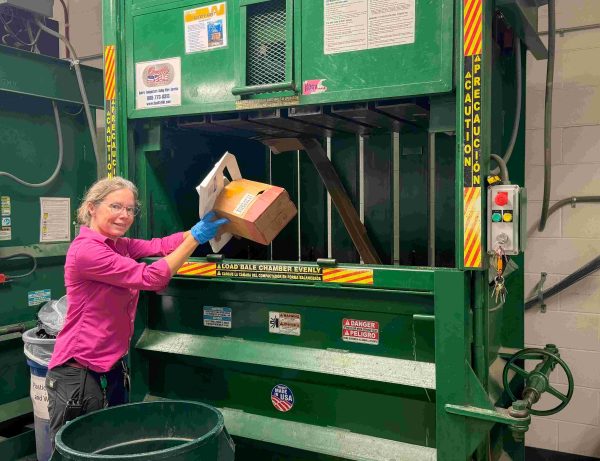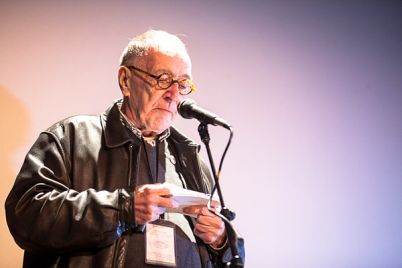
Becky Andrews, resource recovery manager, demonstrates how to bundle bails of cardboard. Once there are four cardboard bails, the team takes the four bails of cardboard off campus to be recycled. Sasha Hatinger | The Washtenaw Voice
Education prevents efforts from going to waste
Sasha Hatinger
Staff Writer
In trying to do the right thing by recycling, students can accidentally jeopardize or ruin the efforts of everyone else by doing it improperly.
Resource Recovery Manager at WCC, Becky Andrews said, “That’s our biggest mistake on campus, is people put in single use plastics in [the] green bin. They have to go in the black bin.”
When cups with liquid or trash with food are put into the recycling container, the green bin, the entire bag of recycled material could be potentially contaminated and therefore unrecyclable.
Andrews went on to explain that single use plastics, including smoothie cups, coffee cups and juice cups must go in the landfill, which is the black bin.
Monique Caldwell, a WCC student majoring in Addictions Studies and Social Work, is passionate about the recycling options available on WCC’s campus.
“I think it’s wonderful, honestly,” Caldwell said.
Students have recycling options on campus, both inside and outside.
Andrews said that students have three recycling options inside; those bins are called ‘Wastewatchers.’
“Students, wherever they recycle on campus, they’re typically going to have three choices,” Andrews said. “They’ll have a bin for bottles, cans and containers. They can be plastic, glass, or metal. They’ll have a bin for paper and cards–any type–notebooks, newspapers, magazines, envelopes,” Then, there is a bin for landfill, or trash.
According to Andrews, there are around ten ‘Big Belly’ containers, that are solar outdoor bins with handles, and around 14 ‘side by sides,’ which are the outdoor bins available for recycling.
The biggest difference between indoor and outdoor recycling is that there is no paper recycling outdoors. Students can only recycle cans and bottles outside.
Andrews has some pointers for students interested in knowing how to properly recycle.
“Number one would be, we only want clean material, and if it’s the single use material like a cup, or a take-out container, or a paper plate, it has to go in the landfill bin,” she said.
Andrews adds, “That may feel like you’re not recycling, but actually what you’re doing is, you’re making sure that all the recycling in the paper and bottles bin gets recycled because you’re keeping it clean.”
Caldwell also has suggestions for students on how to properly recycle. “I would just tell them to make sure when they buy whatever they buy, to look on the bottom, because it does tell you how to recycle, whether it can be recycled or if it should be in a landfill.”
Another important tip both Andrews and Caldwell can agree upon,“If you have the time, you really should rinse out the item as well.”
Students should not feel discouraged about their recycling efforts and the magnitude of the situation in its entirety. In fact, WCC disposed of 160 tons by recycling in 2024 alone.
“Recycling is important, but what’s most important is to use less, and dispose of it in a way that conserves energy to limit the carbon footprint and ensures that it is actually gone and not loose in the environment,” Andrews said. “Recycling is important because one plastic in the environment just persists.”
Find more information about recycling on WCC’s campus here.
WCC also has a surplus store online with products available for auction.
Students interested in tours of the recycling center can email: recycle@wccnet.edu.

